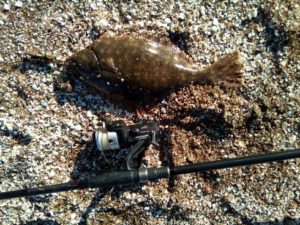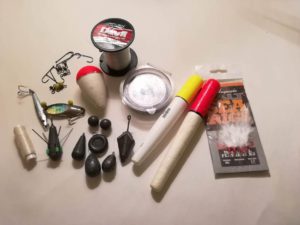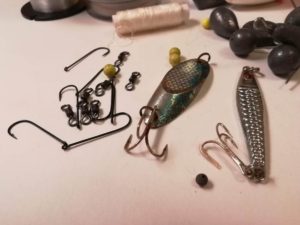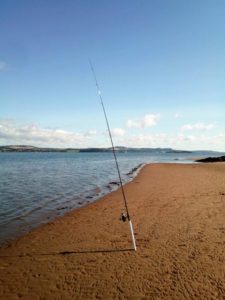Sea fishing tips for beginners – tackle and more

I’ve been a coarse angler since I was a kid, but only started sea fishing when I was already in my thirties. I have always loved the sea but I guess I felt too overwhelmed by the vastness of it. With all that water, where the hell do you start? I only gave sea fishing a serious chance when I moved within walking distance of the sea – and I haven’t looked back since. Here are some sea fishing tips I could have used at the start.
Tackle
Fancy equipment doesn’t catch fish, anglers do. If, like me, you come from a course fishing background it’s worth using what you have before you splash out on more specialised sea fishing tackle. It’s a good idea to start practising with something that ‘will do for now’ until you discover what your specific needs are.
Rod

A 12 ft carp/ pike rod is perfect in a lot of sea fishing situations. It’s suitable for float fishing and spinning and you can cast 2-3 oz weights without much effort. It’s pretty useless when fishing at distance in rough seas. But if you are just taking up sea fishing, rough seas are not the place to start anyway. If you’re completely new to fishing and you don’t have a carp rod lying around I would say a bass rod is probably the best all-round rod you can buy. It’s light enough for float fishing and you can still cast quite decent weights with it. It also has a bit more bullying power than a carp rod.
Reel
If you have a decent size carp reel lying around, that will probably do. If not, for all-round purposes a 5000/6000 size fixed spool reel is perfect. Just remember that sea water is corrosive, so rinse your reel under the tap after every session. Rod guides can corrode pretty quickly too, so it’s a good idea to hose your rod down every now and again.
Line
For all-round sea fishing a line with a 15lbs breaking strain (approx. 0,35mm) is ideal. It’s strong enough in most circumstances but still easy enough to cast. For hooklentghs I would go slightly thinner, (for example 12 lbs amnesia). That way, if you get snagged all you lose is your hook. If you’re planning on using bigger weights, you will also need to use a shock leader.
Bits and bobs

It’s best to start with the basics and adjust your tackle to your needs as you go along. There is no point in buying massive hooks if you’re mostly after mackerel and flounder. The same is true for weights. Don’t waste money on heavy leads if your rod is only rated for up to three ounces.
Hooks
Size 1 aberdeen hooks (for example Kamasan B940) are a good all-round choice. They’re small enough for flounder, but strong enough to land bigger fish.
Swivels
Swivels are almost as essential as hooks. Not only they make it a lot easier to connect different lengths of line, but they also prevent line twist. Size 2 rolling swivels are a good size in most situations, while link swivels of a similar size make it much easier to change lures quickly.
Rigs
If tying your own rigs feels too ambitious, you can always buy a few ready-mades. To start with, a couple of ‘flapper’ or paternoster rigs will do the job. You might want to adjust the length of the snoods to your needs.
Weights
If you use the tackle I suggested above, you can keep your tackle box relatively light. For float fishing you will need some 1oz drilled bullet weights. For all-round ledgering and fishing with feathers plain 2-3 oz leads are perfect. A few 3oz grip leads for when there is a stronger current might also come in handy.
Floats
There are a lot of different sliding sea floats on offer but a float that takes a 1oz lead (like the Tronix pro 35g) works in most conditions. Sometimes these floats are supplied complete with beads and hooklength. The supplied hooklength is often a bit flimsy, so you’re probably better off tying your own.
Lures

A couple of spinners and some feathers are great to start with. No need for anything fancy. Cheap silver minnow spinners are often the best. Be aware that you will lose a lot more tackle with lures than with float fishing.
Bait elastic
Probably one of the most important sea fishing tips: never leave your house without bait elastic. Wrapping the bait to your hook with this magical thread can make all the difference, especially with softer baits.
Marks
When you’re a beginner at sea fishing it makes sense to start with the easier marks. If you choose a rough ground mark for your very first sea fishing trip and lose all your tackle straight away, you might never want to go sea fishing again.
Piers and breakwaters
Piers and breakwaters are perfect for beginners because they give access to deeper water without the need to cast very far. Float fishing for species like mackerel is a great way to get into the sport and it’s so much fun you might not want to do anything else. Lure fishing with spinners or feathers is another successful summer mackerel tactic. To read more about all the ways you can catch mackerel, read this post. Of course mackerel is not the only species you can catch. If you’re lucky you can catch garfish, pollock, coalies, wrasse. Mackerel is one of the best all-round baits too. Bait up a two-hook flapper rig with strips of mackerel and you can also catch species like dogfish, dab and flounder. Ragworm is another very good bait for most species and available in most tackle shops. But you can also dig your own of course.
Beaches
Clean beaches (without reefs and rocks) are also a great place to start. No snags means you lose very little tackle. Flounder and bass are often found very close in so distance is not an issue most of the time. Strips of mackerel (preferably self-caught from the pier) are a very good bait for beach fishing. Lugworm and ragworm work well too. Again, a two-hook flapper rig is the best choice in most situations.

You can hold the rod in your hand or use a rod rest. A tripod is the most stable, but if you’re just trying to see if beach fishing is something for you, a piece of PVC tube cut at an angle will do the job. You can always invest in a decent tripod later. Keep an eye on the beach behind you to make sure you don’t get cut off by the tide. And it’s a good idea to wear wellies to keep your feet dry. Sea conditions play a bigger part in beach fishing than when you’re fishing from a pier. For more information, please read my article on sea fishing conditions.
Estuaries
Estuaries are perfect beginner territory. Because the conditions are often a lot calmer than at open sea, you can fish a lot lighter. A carp rod coupled with a flapper rig and a two ounce weight is often more than enough for targeting flounder.
More sea fishing tips
Summer
Summer is the ideal time to start sea fishing. There’s plenty of fish around and the conditions are usually a bit calmer. If you really get into it, you can still chase the cod the following winter. Of course you will have to upgrade your gear a bit.
Casting
Distance is not (always) that important. Don’t be intimidated if you see other anglers blast baits out at over a hundred yards. There’s a good chance that they’re actually a lot further away from the fish than you are. Even if you turn into a tournament caster, it’s always a good idea to start very close in and increase your distance until you start getting bites. That way you don’t waste any time casting past the fish.
Casting style
There are a lot of casting styles but to begin with I would suggest a simple overhead style. Depending on the marks you fish, it might even be the only casting style you will ever need.
Bait
Change your bait regularly. Bait can lose its scent pretty quickly, it’s a good idea to change it every 30 minutes or so. Also, crabs can strip your bait in no time, so if you don’t reel in regularly to check your bait you could be fishing with an empty hook.
Make sure your bait is fresh. You can have the fanciest equipment available but in the end it comes down to mostly one thing: your bait. If you’re using frozen bait, take it out of the freezer just before your session and try to keep it cool during the day. It’s always better to refreeze your leftover bait than to have it sit in your fridge for too long. If it smells bad, don’t use it (unless you’re targeting dab or dogfish).
The same is true for worm baits: keep it wrapped in newspaper and out of the sun. For more info on bait, see this post.
Hooks
Always make sure your hooks are sharp. If you keep on missing bites, there’s a good chance your hook is blunt.
Line
There are a lot of things out there that can damage your line: rocks, barnacles, limpets; so check it regularly for weak points. You don’t want it to snap when you have a fish on.
Knots
Knots are important. Poorly tied knots can result in lost fish and can be hazardous when you’re casting heavy weights. There are hundreds of fishing knots, but to start with I suggest you learn just one: the uni knot. The uni knot and variations of the uni knot will be all you need in most sea fishing situations.
Be adventurous
There are no definite rules. Explore. Experiment. Find out what works for you. The possibilities are endless.

Hopefully these sea fishing tips will get you started. Have a look at my other blog posts for more detailed information. Please share your experiences in the comment section below.
And if you’d like to receive an email every time I publish a new post, please subscribe to my newsletter. Tight lines!
Disclosure: if you purchase anything using the links in this blog post, I might make a commission. Affiliate programs and affiliations include, but are not limited to, the eBay Partner Network. It doesn’t cost you a penny more to buy via these affiliate links (and you don’t have to use them of course) but it helps me to keep this blog going. Thanks!